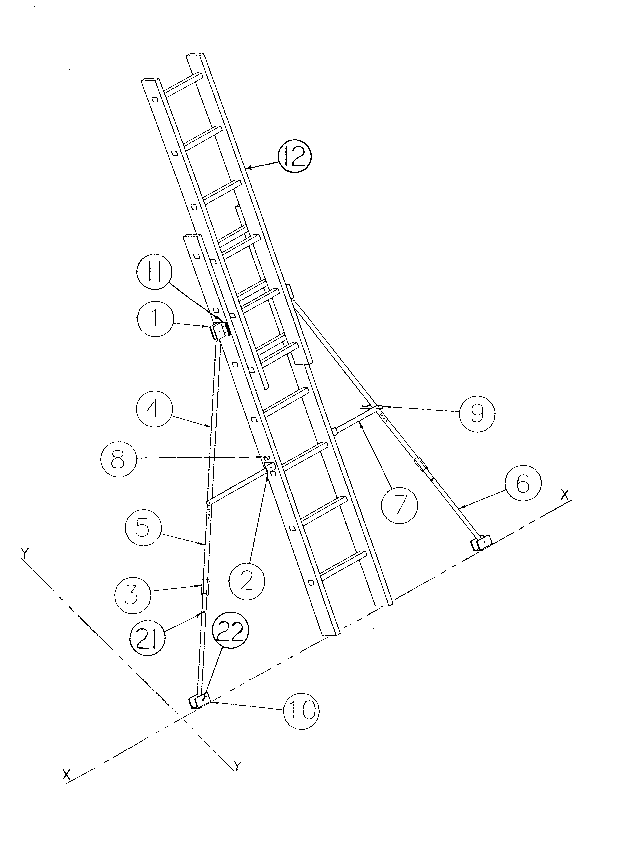Some of the information on this Web page has been provided by external sources. The Government of Canada is not responsible for the accuracy, reliability or currency of the information supplied by external sources. Users wishing to rely upon this information should consult directly with the source of the information. Content provided by external sources is not subject to official languages, privacy and accessibility requirements.
Any discrepancies in the text and image of the Claims and Abstract are due to differing posting times. Text of the Claims and Abstract are posted:
| (12) Patent: | (11) CA 2118436 |
|---|---|
| (54) English Title: | LADDER STABILISERS |
| (54) French Title: | STABILISATEUR D'ECHELLE |
| Status: | Expired and beyond the Period of Reversal |
| (51) International Patent Classification (IPC): |
|
|---|---|
| (72) Inventors : |
|
| (73) Owners : |
|
| (71) Applicants : |
|
| (74) Agent: | |
| (74) Associate agent: | |
| (45) Issued: | 1997-02-18 |
| (22) Filed Date: | 1994-10-19 |
| (41) Open to Public Inspection: | 1996-04-20 |
| Examination requested: | 1994-10-19 |
| Availability of licence: | N/A |
| Dedicated to the Public: | N/A |
| (25) Language of filing: | English |
| Patent Cooperation Treaty (PCT): | No |
|---|
| (30) Application Priority Data: | None |
|---|
Ladder stabilizers for lateral attachment to an extension
ladder for inhibiting sideways slipping and falling thereof
accordingly to full safety. Both sides of a ladder are
attached to the side rail a long tube support made from non-
rusting metal and connected approximately in its middle with
a non-articulated bracing forming an A frame with the ladder.
The lock for the telescoping sections visibly indicates they
are locked, this as per American National Standard ANSI A14.2-
1990, par. 6.7.10, the installation being fully secured
because of the technically safe locking device the telescopic
tube is blocked with a spring pin. Ladder stabilizers are
telescopic tubes for uneven ground and are pivotable along
only the same surface of the ladder, thus enlarging the
sustension polygone for ladder support. For storage position,
horizontal braces are detached and rotate on a metal
attachement on the side rail of the ladder to become parallel
with the ladder, the telescopic tubes are also in the same
position and are firmly tied with a tension hook. This ladder
stabilizer is to be added to any existing ladder extensible or
non-extensible.
Note: Claims are shown in the official language in which they were submitted.
Note: Descriptions are shown in the official language in which they were submitted.

2024-08-01:As part of the Next Generation Patents (NGP) transition, the Canadian Patents Database (CPD) now contains a more detailed Event History, which replicates the Event Log of our new back-office solution.
Please note that "Inactive:" events refers to events no longer in use in our new back-office solution.
For a clearer understanding of the status of the application/patent presented on this page, the site Disclaimer , as well as the definitions for Patent , Event History , Maintenance Fee and Payment History should be consulted.
| Description | Date |
|---|---|
| Time Limit for Reversal Expired | 2011-10-19 |
| Inactive: Adhoc Request Documented | 2011-07-21 |
| Letter Sent | 2010-10-19 |
| Small Entity Declaration Determined Compliant | 2007-10-17 |
| Extension of Time to Top-up Small Entity Fees Requirements Determined Compliant | 2007-10-11 |
| Inactive: Office letter | 2007-10-11 |
| Inactive: Office letter | 2007-07-13 |
| Inactive: IPC from MCD | 2006-03-11 |
| Inactive: Late MF processed | 2005-10-26 |
| Letter Sent | 2005-10-19 |
| Inactive: Office letter | 2005-10-17 |
| Inactive: Office letter | 2002-06-21 |
| Change of Address Requirements Determined Compliant | 2002-06-21 |
| Grant by Issuance | 1997-02-18 |
| Application Published (Open to Public Inspection) | 1996-04-20 |
| Request for Examination Requirements Determined Compliant | 1994-10-19 |
| All Requirements for Examination Determined Compliant | 1994-10-19 |
There is no abandonment history.
The last payment was received on
Note : If the full payment has not been received on or before the date indicated, a further fee may be required which may be one of the following
Please refer to the CIPO Patent Fees web page to see all current fee amounts.
| Fee Type | Anniversary Year | Due Date | Paid Date |
|---|---|---|---|
| MF (patent, 4th anniv.) - small | 1998-10-19 | 1997-08-21 | |
| MF (patent, 5th anniv.) - small | 1999-10-19 | 1999-08-04 | |
| MF (patent, 6th anniv.) - small | 2000-10-19 | 2000-10-15 | |
| MF (patent, 7th anniv.) - small | 2001-10-19 | 2001-08-02 | |
| MF (patent, 8th anniv.) - small | 2002-10-21 | 2002-08-16 | |
| MF (patent, 9th anniv.) - small | 2003-10-20 | 2003-08-08 | |
| MF (patent, 10th anniv.) - small | 2004-10-19 | 2004-08-03 | |
| MF (patent, 12th anniv.) - small | 2006-10-19 | 2006-09-18 | |
| MF (patent, 13th anniv.) - small | 2007-10-19 | 2007-08-02 | |
| MF (patent, 14th anniv.) - small | 2008-10-20 | 2008-08-08 | |
| MF (patent, 15th anniv.) - small | 2009-10-19 | 2009-08-25 | |
| MF (application, 2nd anniv.) - small | 02 | 1996-10-21 |
Note: Records showing the ownership history in alphabetical order.
| Current Owners on Record |
|---|
| FRANCOIS CHARBONNEAU |
| Past Owners on Record |
|---|
| None |